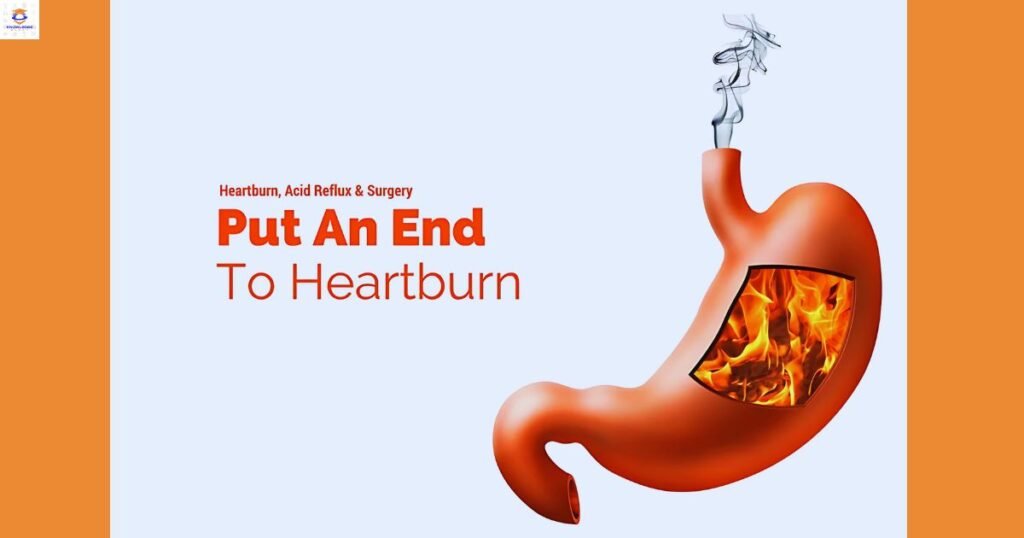Heartburn and acid reflux are extremely common conditions that many people experience at some point in their lives. While occasional heartburn after a heavy meal is normal, frequent or persistent heartburn symptoms should not be ignored. Heartburn and Acid Reflux Understanding the root causes and risk factors for heartburn and reflux is key to finding the right treatments and preventative strategies.
Read More: Heart Mutation

What is Heartburn?
Heartburn refers to a painful, burning sensation in the center chest or throat. It often feels like a burning tightness or heat moving from the stomach up into the chest. Heartburn is caused by acid reflux, which happens when stomach acid backs up into the Heartburn and Acid Reflux esophagus, the tube connecting the throat to the stomach. The esophagus is not designed to handle acidic stomach contents, so acid touching this tissue produces irritation, inflammation, and pain.
Heartburn usually develops after eating, when lying down, or when bending over. It can last for minutes to hours. Some describe heartburn as feeling like food is coming back into the mouth accompanied by a bitter or sour taste. About 60 million Americans experience heartburn at least once a month.
What is Acid Reflux?
Acid reflux refers to the backflow of stomach acid into the esophagus. It is also called gastroesophageal reflux disease (GERD) or simply reflux. Acid reflux occurs due to a weakness in the lower esophageal sphincter (LES), the ring of muscle that separates the esophagus from the stomach and normally prevents backflow. Certain foods, medications, and health conditions can weaken or relax the LES and cause reflux.
When the LES relaxes inappropriately, acidic digestive juices from the stomach can rise up into the esophagus. This acid irritates and damages the esophageal Heartburn and Acid Reflux lining which is not designed to handle acidity. Frequent acid reflux leads to inflammation, ulcers, and scarring of esophageal tissue known as erosive esophagitis. The main symptom of acid reflux is heartburn.
What Causes Heartburn and Reflux?
There are several contributing factors to reflux and heartburn:
- Weak lower esophageal sphincter – This muscle ring should prevent stomach contents from entering the esophagus. If the LES relaxes abnormally or weakens, acid can reflux.
- Hiatal hernia – This is when part of the stomach protrudes up through the diaphragm into the chest, allowing acid to more easily flow up.
- Pregnancy – Hormonal changes and pressure from the uterus can cause acid reflux symptoms.
- Obesity – Excess weight puts pressure on the stomach and makes reflux more likely.
- Medications – Drugs like antihistamines, calcium channel blockers, antidepressants, and sedatives can cause relaxation of the LES.
- Poor diet – Spicy, fatty, or acidic foods and drinks like alcohol, chocolate, citrus, coffee, and soda can trigger reflux.
- Smoking – This impairs muscle function in the LES.
- Large meals – Overeating places excessive pressure on the LES and stomach.
By identifying your personal reflux triggers, you can take steps to prevent heartburn flare ups through diet, posture, and lifestyle changes.
Acid Reflux Symptoms
The most common symptom of acid reflux is heartburn, which is a burning discomfort usually felt central to the chest. Other associated symptoms include:
- Regurgitation or taste of sour food or liquid
- Sense of a lump in the throat
- Nausea
- Chest pain
- Bitter taste in mouth
- Excessive belching
- Excessive throat clearing
- Chronic cough
- Halitosis
- Trouble swallowing
- Wheezing
- Hoarseness or sore throat
Symptoms tend to worsen when bending over, lying down, exercising after eating, or eating heavy, fried, or spicy foods. If reflux symptoms occur more than twice weekly or disrupt daily life, see your doctor.

Long-Term Effects of Uncontrolled Reflux
Left ignored without proper treatment, acid reflux can lead to serious health complications:
- Esophagitis – Chronic inflammation and damage of esophageal tissue. Can lead to open sores, ulcers and scarring.
- Strictures – Narrowing of the esophagus from continual damage. Heartburn and Acid Reflux Causes difficulty swallowing.
- Barrett’s esophagus – Pre-cancerous changes in esophageal lining from repeated exposure to stomach acid. Can progress to cancer.
- Respiratory issues – Stomach acid entering airways can cause wheezing, pneumonia, and worsen asthma.
- Tooth decay – Stomach acid can wear away tooth enamel.
Getting recurring heartburn and reflux under control is essential to avoid further damage and problems.
Risk Factors for Heartburn and Acid Reflux
Certain individuals have a higher risk of experiencing acid reflux and heartburn:
- Pregnancy – Pressure from the growing fetus and hormonal shifts weaken the LES.
- Obesity – Excess body weight increases pressure on the stomach and esophagus. Losing weight helps relieve symptoms.
- Hiatal hernia – Stomach protruding through the diaphragm impairs the LES barrier function.
- Smoking – Impairs muscle function in the LES. Quitting smoking is advised.
- Alcohol use – Weakens the LES and increases acid production.
- Medications – Drugs like antihistamines, antidepressants, sedatives and calcium channel blockers promote acid reflux.
- Age – The LES can weaken with age. People over 60 experience more reflux issues.
- High fat diet – Fatty and greasy foods impair LES function and trigger heartburn.
- Food triggers – Spicy foods, chocolate, citrus, coffee, and soda can aggravate reflux.
Knowing your reflux triggers provides insights on lifestyle and diet changes to prevent flare ups.
Diagnosing Heartburn and Acid Reflux
To evaluate heartburn and acid reflux, physicians consider a person’s symptoms, risk factors, and perform diagnostic testing:
- Medical history – The pattern, frequency, and severity of symptoms offers clues to the reflux cause. Associated conditions like asthma and sleep apnea are also assessed.
- Physical exam – Doctors observe the throat and esophagus looking for signs of inflammation, ulcers, or strictures. They palpate the abdomen assessing Heartburn and Acid Reflux for any masses or enlarged organs.
- Endoscopy – A lighted tube with a camera (endoscope) is inserted down the throat allowing visualization of esophageal tissue. Collected tissue samples are tested.
- Esophageal manometry – Pressure sensors are placed in the esophagus to measure muscle contractions and the coordination between esophagus and stomach.
- pH monitoring – A probe placed in the esophagus records acidity levels to identify reflux patterns and frequency.
These exams determine if and how severely acid reflux is occurring so appropriate treatments can be determined.
Lifestyle Changes to Treat Heartburn and Reflux
Along with medical treatment, lifestyle and diet modifications are important for controlling acid reflux:
- Lose weight if overweight – Extra pounds put pressure on the stomach and esophagus promoting reflux.
- Avoid trigger foods – Fried, spicy, and acidic foods, citrus, chocolate, alcohol, caffeine, and carbonated drinks can worsen reflux.
- Eat smaller meals – Large meals overfill the stomach placing excessive pressure on the LES.
- Don’t lie down after meals – Give your body 2-3 hours to digest before lying down to keep acid down.
- Quit smoking – Smoking impairs the LES muscle, so quitting is advised.
- Wear loose clothing – Tight belts, slender jeans, and control top nylons can increase abdominal pressure.
- Elevate the head of your bed – Let gravity help keep acid down by propping up the top of your mattress by 4-6 inches.
- Avoid late night eating – Finish meals 3 hours before bedtime to improve nighttime reflux.
Making dietary adjustments and lifestyle changes help complement medical reflux therapies.
Medications for Heartburn and Reflux Relief
A variety of over-the-counter and prescription medications provide heartburn relief:
Antacids – These fast-acting medications like Tums and Rolaids neutralize existing stomach acid and provide rapid relief. They typically contain calcium carbonate or magnesium and aluminum hydroxide. Best for occasional or mild heartburn.
H2 blockers (antihistamines) – Pepcid, Tagamet, and Heartburn and Acid Reflux Zantac block histamine receptors that stimulate acid production, reducing future acid. Offer longer relief up to 12 hours.
Proton pump inhibitors (PPIs) – Prilosec, Nexium, Prevacid shut down acid pumps in stomach cells, significantly reducing acid production for 24+ hours. Most potent medications but not meant for long-term use.

Prokinetics – Reglan and metoclopramide improve stomach emptying and strengthen the LES to prevent reflux. Useful for certain cases.
Surgery is an option for those with severe, chronic Heartburn and Acid Reflux not responsive to other treatments. Fundoplication surgery tightens the LES to prevent reflux.
Work closely with your doctor to determine the most appropriate medications based on your reflux severity, type, and frequency. Make sure to take medications as directed.
When to See Your Doctor
Consult your physician if you experience:
- Frequent heartburn more than twice a week
- Difficulty or pain swallowing
- Unexplained weight loss
- Wheezing or chest pain with reflux
- Persistent hoarseness or sore throat
- A large amount of reflux when lying down
Signs of complications warrant prompt medical care. Heartburn and Acid Reflux With proper treatment, most people get lasting relief from uncomfortable heartburn and acid reflux.
Conclusion
While occasional heartburn is normal, having persistent reflux symptoms more than twice weekly calls for evaluation and treatment. Left uncontrolled, heartburn and acid reflux can impact daily life and cause complications like esophagitis, ulcers, strictures, and Barrett’s esophagus. The good news is heartburn is highly manageable through lifestyle Heartburn and Acid Reflux changes and medical therapies. Losing weight, avoiding trigger foods, not smoking, wearing loose clothes, taking antacids or acid reducers, and sleeping propped up can prevent flare ups. Work with your doctor to find the combination approach that brings Heartburn and Acid Reflux the most relief. Monitoring what triggers your heartburn and making healthy choices offers the best chance for feeling your best.
Read More: Heartburn and Acid Reflux 2023
FAQs:
What’s the difference between heartburn, acid reflux, and GERD?
Heartburn refers to the burning chest pain.
Acid reflux means stomach acid backs up into the esophagus.
GERD or gastroesophageal reflux disease is chronic acid reflux occurring at least twice weekly.
What are the main causes of acid reflux?
The main causes are weakened lower esophageal sphincter, hiatal hernia, pregnancy, obesity, certain medications, smoking, large meals, and unhealthy diet.
What are the most common symptoms of reflux?
Frequent heartburn, regurgitation, nausea, sore throat, trouble swallowing, coughing, and chest pain are most common. Symptoms worsen when lying down or after eating.
What foods commonly trigger heartburn?
Fried foods, spicy foods, citrus, tomato, chocolate, caffeine, alcohol, carbonated drinks, and any foods with high acidity commonly trigger reflux.
How can you prevent heartburn without medications?
Lifestyle changes like losing excess weight, eating smaller meals, avoiding trigger foods, not lying down after eating wearing loose clothes, quitting smoking, and sleeping propped up can prevent heartburn for many.






